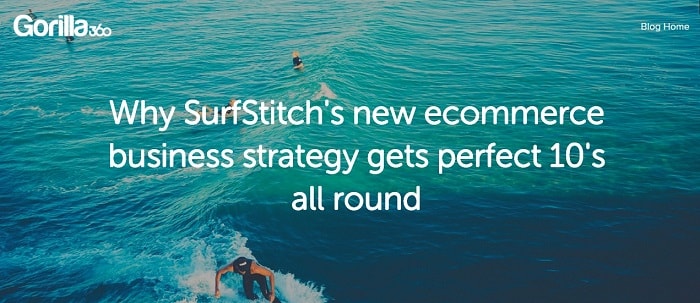 Sometimes it’s hard to see the jungle for the vines.
Sometimes it’s hard to see the jungle for the vines.
Selling online involves a whole bunch of day-to-day mayhem.
‘The big picture sounds more like your five-year-old nephew’s description of the giant poster on his wall, than something you prepare for at work.
Finding time to futureproof your business is a luxury most eCommerce pro’s are lucky to have, especially in the Christmas shopping red zone.
We gorillas have got you covered. This month’s bundle of wisdom is a thought-provoking, head-scratching, idea-generating feast.
Take 15 minutes, forget about your Christmas shopping preparation anxieties, and we’ll get you excited for some big things coming up on the eCommerce horizon.
Oh – and we’ve also got a little gift to help you manage the ecommerce silly season as well.
The TL;DR (Too Long; Didn’t Read) summary this October
We’re going to pose some juicy questions this month, including;
- How will your ecommerce store develop an offline presence? We explain why Amazon’s announcement to open a bricks and mortar store is a bellwether moment for the ecommerce industry.
- Have you overstepped the line to generate more efficiencies? The cut-throat competition of online retail keeps a constant pressure on price points. It’s never been easier for a customer to find a cheaper option. We’re so focused on increasing efficiencies to protect our margins, but how much pressure is too much pressure?
- Is it time for your brand to purchase a media publication? An audience of loyal repeat customers is the most valuable asset an ecommerce brand can have. But building that audience from scratch is so difficult. It takes time, money and lots of patience. There could be a better way. It’s an off-the-shelf shortcut we haven’t seriously considered. It’s time for your brand to go audience shopping.
And of course, that age old marketing classic…
- What are the ramifications of wearing nothing but your underwear to work? Are near-naked board meetings ever a good idea? American Apparel CEO Dov Charney thinks so. His shareholders – not so much. Our read of the month explores the dangers of taking an innovative culture and an edgy brand just a little bit too far.
From Clicks to Bricks – Amazon has finally ventured offline
For so long, Amazon’s online advantage crippled yesterday’s bookstore behemoths. The absence of overheads allowed the ecommerce powerhouse to continually undercut the prices of their brick and mortar contemporaries to the point of extinction.
The book was the perfect online gamechanger.
You don’t need to try it on, you don’t need to test it, there’s no other brands or versions of each product to compare, and it’s super easy and relatively inexpensive to ship.
There’s a bittersweet irony for book lovers in this decision…
The unique nature of the product is exacgtly what lured Amazon into creating its first physical store which opened in Seattle on November 3.
It’s the sensual experience of book shopping that twisted the online retailer’s arm.
Many booklovers still miss this:

The magic of losing yourself in browsing through shelves, the instant excitement of receiving your purchase, and the helpfulness of real customer service assistants are something Amazon.com can’t quite replicate.
The problem for traditional book retailers – people want this experience at Amazon prices.
What does this mean to your ecommerce brand?
Take Amazon’s lead very seriously. These folks know what they’re doing.
Couple this move with the collection of successful online retailers that have already complemented their ecommerce experience with bricks and mortar stores, and you have a compelling question to ask yourself as a pureplay retailer:
Is it time to consider investing in an offline store?
CNBC has highlighted 10 of the highest profile pureplay retailers to take the offline plunge, but Warby Parker, Bonobos, and closer to home, Australian success story Shoes of Prey (pictured below), have made the retail reverse engineering job work.

Why your ecommerce brand could use an offline presence
Online retailers struggle to generate a physical representation of their brand.
Without a print magazine, your product packaging is almost the only tangible customer-facing expression of your story.
An in-store experience can change all that.
Online retailers have incredibly rich user data. You can use the insights you get from your ecommerce company to inform the development of an effective bricks and mortar store – just like eyewear industry disruptors Warby Parker have now done 14 times over.
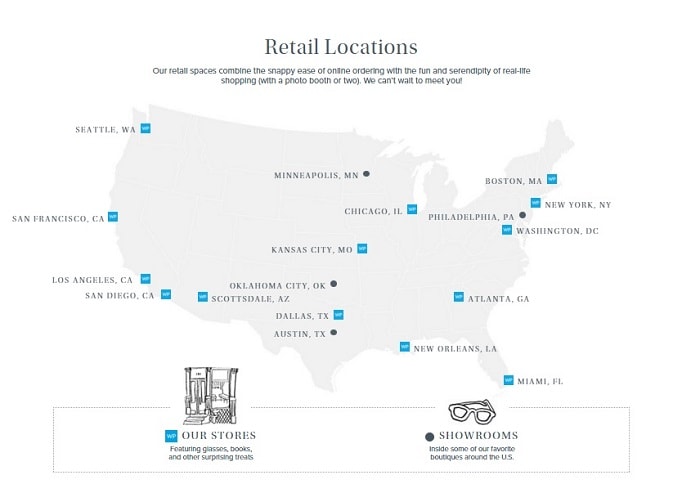
Location based information, combined with hyper-targeted product preferences allow Amazon to curate an almost perfect shopping experience, avoiding the perennial bookstore problem of unwanted titles attracting dust on shelves and losing money in warehouses.
Your bricks and mortar store can be the most amazing customer acquisition mechanism.
You have the chance to develop a relationship in person, then nurture that relationship with your online marketing program. After your first in-store visit, you can sign your subscriber up to email, and repeatedly share valuable content to solidify the trust of your new friend.
When they are ready to buy again, your online store experience will be ready, in all its convenient glory.
NORA Chief Executive Paul Greenberg explained the trend developing amongst ‘pureplay’ retailers of dabbling in bricks and mortar in an interview with the Sydney Morning Herald:
“It’s just retail. It’s never going to be either/or,” Greenberg says “Think about where your customers would like to meet you… What you want to aim for is the right brand and multiple touch points. It’s the brand that shoppers want to engage with – how they do it is secondary.”
We reckon Paul is spot-on.
In September’s Ecommerce Marketing Bundle we brought you the story of traditional retailers forecasting the death of ecommerce. While the mud-slinging and industry bickering flies around, it’s pretty easy to see these folks are missing the point.
It’s no longer an online versus offline divide.
As we put it in September;
“Are we all just missing the point here?
Increasingly, our industry (and our customers) are beginning to see this debate as an irrelevant one. Retail now includes online and offline channels.
Just as the word ‘digital’ is now increasingly redundant when placed before the word ‘camera’ – retail almost always includes an online component (with a few notable exceptions, including car and petrol sales).
Measuring and comparing the growth of online as opposed to offline retail is becoming obselete.”
The advantages of online retail haven’t diminished.
There’s not some fast approaching eCommerce armageddon driving online-only brands to start opening stores. Smart brands are just finding better ways to improve their online customer’s experience.
And don’t restrict yourself to the overwhelming prospect of opening a ‘traditional’ retail store…
Think strategically and consider innovative retail options
Expect ecommerce retailers to turn bricks and mortar on its head. We digital natives know and relish disruption. Why do offline retail the way its always been done?
There’s a number of different offline retail models that can work to complement your online business:
- Click and collect warehouses that double as IKEA style showrooms for customers to physically experience products
- Collection kiosks in urban shopping hubs, allowing online shoppers to pick up their purchase, try/test/touch it, then return it straight away if it’s not quite right
- Pop-up stores that travel across countries looking to attract new customers and nurture them into a long term online purchasing relationship
- Seasonal, events-specific stores launched for finite periods to improve service levels during high demand periods
- Specially designed bricks and mortar stores, located and stocked based on user data from online purchases
Amazon went with the fifth option, but any one of these might work for you.

The dark side of increasing ecommerce efficiency
It seems like every month we have some gravely conflicting news around the Amazon brand that throws all of their incredible innovation into slightly sinister shadow.
Last month it was The New York Times’ investogation into Amazon’s agressive corporate culture and the resulting impact on the mental wellbeing of white collar employees.
This October, we turn our attention to the backroom blue-collar staff, and the confronting story of the death of an Amazon warehouse employee and an exploration of the impact (if any) the company had in contribution to this tragedy.
Huffington Post’s incredible digital storytelling platform, Highline, investigated Amazon warehouse contractor Jeff Lockhart Junior’s death and the surrounding circumstances that trigger broader questions around the expectations brands set for their retail employees.
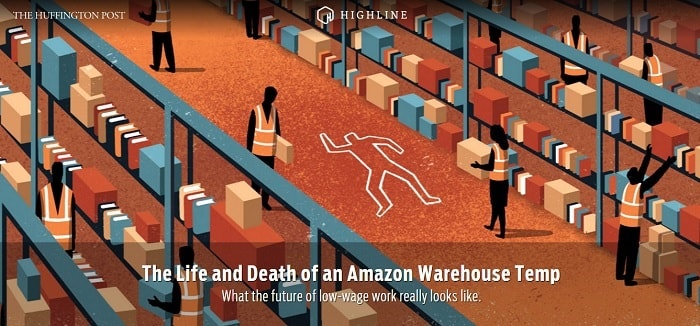
Highline is a serious publication. The exploration of this issue is solemn and detailed. Highline describes itself as:
“An online magazine that only runs cover stories—big, ambitious pieces intended to change the way you see the world or influence the course of policy. Investigations will take months, essays will be finely considered, the subjects we choose to write about will feel urgent and essential.”
If you work in ecommerce, or retail in general, this piece will make you stop and think about the way you manage your employees.
Where’s the line between ruthless efficiency and unfair expectations?
Author Dave Jamieson explores this question through the lense of the world’s biggest online retailer:
“We are living in an era of maximum productivity. It has never been easier for employers to track the performance of workers and discard those who don’t meet their needs. This applies to employees at every level, from warehouse grunts to white-collar workers like those at Amazon headquarters”
The Chester warehouse where Jeff died has 3,000 full time employees and a fluctuating level of contractors. Since opening in 2012, more than 180 emergency calls were logged. As the article explains;
“Many of them (were) for patients in their 20s and 30s. The most common issues cited were difficulty breathing, chest pains, cardiac problems, spells of unconsciousness or other undefined illnesses.”
Integrity – the agency that manages Amazon’s warehouse contractor workforce, provides this message to any prospective applicants before entering negotiations:
“IT’S GOING TO BE HARD, you will be on your FEET the entire shift and walking upwards of 12 MILES per shift. (yeah, that’s really far!) … YOU WILL HAVE TO: LIFT, BEND, SQUAT, REACH & MOVE (there are no sit-down positions.) DON’T BE AFRAID; YOU CAN DO IT.”
Ordinarily this warning would seem relatively innocuous at best, and slightly intense at worst.
Considered in the context of Jeff Lockhart Junior’s death, the forecast is slightly chilling.
There’s no indication that Amazon were in any way directly responsible or contributory to Jeff’s death, but the culture of the retailer’s operations led author Dave Jamieson to raise some serious questions. Did the company expect too much physically from their warehouse employees?
“The autopsy doesn’t suggest that Jeff died of an ordinary heart attack. If he was exerting himself when he collapsed, Abraham added, hypertrophic cardiomyopathy would be “high on the list” of possible causes. This condition, known to sometimes kill young athletes in the middle of competition, causes the heart to beat out of rhythm, frequently during strenuous activity.”
Regardless of the conjecture, the lesson here is clear.
We all want things to be faster, cheaper and more efficient. Especially when you’re dealing with a fulfillment centre like this:

Most ecommerce business models demand such efficiencies.
But a ‘110%’ culture can have serious implications. The short term benefits will be dwarfed by the long term fall out.
You need to make sure your team works hard, plays hard and rests well. Don’t forget that last bit.
It’s time for your ecommerce brand to create a media company
The announcement of the closure of ESPN’s online sporting publication Grantland probably seems like it has absolutely nothing to do with your ecommerce brand’s marketing strategy.

Two important thought-provoking articles will convince you otherwise.
Joe Pulizzi – the ‘godfather’ (and term-coiner) of content marketing – used ESPN’s announcement as a call-to-arms to brand marketers.
The question he asks;
“Why isn’t a brand buying Grantland to build their audience?”
Joe used the announcement as a challenge to ecommerce brands (and marketing professionals in general) to consider the long term benefits of acquiring an existing publication rather than trying to build an audience of subscribers from scratch;
“If I were Nike, Under Armour, Puma…or even the NBA or NFL…or possibly even Ford or Kia, I would be licking my chops. Why you say? The Nike’s and Under Armour’s of the world should be standing in line to purchase the rights to Grantland.
Yes, you heard me…
Nike should buy Grantland.com.”
Ecommerce pro’s know that acquiring new customers, and turning them into loyal, lifetime brand fans is what constitutes sustainable success.
In our August Ecommerce Marketing Bundle, we quoted a report from RJ Metrics into the common success factors of fast-growing ecommerce companies:
“75% of senior executives say that customer lifetime value (CLV) is an extremely important indicator for success. The competitive advantage is clear. An ecommerce business using CLV to understand buyer behavior is ahead of the curve.”
So what’s the most effective way to meet, nurture and retain ecommerce customers?
Regular provision of helpful, valuable content seems to work out just fine.
That’s pretty well exactly what publishers do. So why shouldn’t we bring in the experts to improve our CLV?
Joe explains the multi-faceted benefits an eCommerce sports brand could generate from purchasing Grantland;
“With Grantland comes a treasure trove of amazing (well indexed by Google) content and a prolific writing team. But more than that, Grantland offers subscribers, who access its content and provide all types of amazing data about what they like, don’t like, and their intent for purchase.
And the best part is this – Nike, Under Armour, Puma, etc. could all buy Grantland for the cost of a rounding error of their total marketing and advertising spend.”
Grantland had feverishly passionate and loving fans. If sports media had an Academy Awards night, the site would have been odds-on to win best publication. Their content was genuinely best in class, created by the best editors and writers in the business.
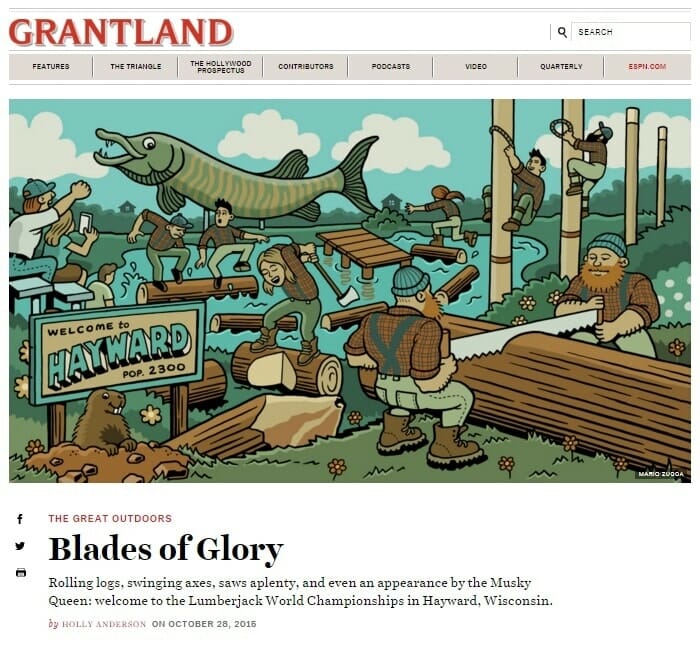
The site failed primarily because ESPN needs to sell more ads. That’s the publishing business model.
An ecommerce brand doesn’t face this problem. We sell products.
The Grantland of your brand only needs to attract, delight and add value for your customers. Your online store and your email marketing still give your subscribers the chance to buy. You don’t need to turn your Grantland into a shameless brand promotion. Just keep your publication developing an amazing experience for your audience. You’ll sky-rocket that CLV figure and generate a bunch of priceless data in the process.
All this for an investment that pales in comparison to the advertising budget that Nike or Under Armour spends every year. You’re purchasing yourself a genuine business asset.
Unlike advertising dollars that offer a finite return over a set campaign period, your publication will keep attracting and retaining new customers for months, years and hopefully decades after your purchase.
Argument closed.
* Deep Breath *
That was your marketing Inception moment.
You can have a moment to recover.

Can you seriously just go out and buy a publisher?
Outrageous idea, right? It probably hurt your head a little.
And don’t feel ashamed you’ve never considered this concept. Not many have.
Some trailblazers have nailed it though.
And one of the biggest in Australia, SurfStitch, have gone all-in on the publication purchase play. We explained the strategy in detail earlier this year.
There’s absolutely nothing stopping you. But as an industry, we’re not quite there yet. Because this idea is still a revolutionary one, first movers feel like a singer walking out onto an opening night packed stage. Without rehearsals. Naked.
You’d have to be one brave ecommerce marketer to pull this one off right now.
Unfortunately, the biggest stumbling block is the publishing industry’s perception that we brands are all blood-sucking, ethics-crushing snake oil salesmen.
Most media industry pundits believe any brand purchase of a reputable publication would result in a mass walk-out from existing staff members who assume the big bad business will tear up their editorial license and force them to start writing glorified advertising copy.
How you can prove the doubters wrong (hint: do better marketing)
Clearly, we brands aren’t in this strategy for the sales opportunity. It’s audience delight (and priceless data) we’re after. The selling is best left to the marketers.
But how do we convince the media industry we’re serious about supporting quality journalism without pressure from overbearing marketers?
Jay Acunzo, VP of Platform at NextView Ventures, Host of the Traction podcast, blogging wizard of Sorry For Marketing, and Jack of All Other Marketing Trades, explained exactly what needs to happen in a passionate rallying cry for our industry (that doubled as a must-read blog article).
His ‘CTA’ is simple;
“This is a call to start lending more credibility to creative in content marketing.”
Jay knows we need to do a better job with our marketing. We have to prove we care about our audience, not just their wallet.
We need to send the message to professional content creators that brand marketing respects, craves and rewards their skills.
“We watch as a subset of our industry tries to make dud missiles fly and, when it doesn’t work, they revisit the color paint they used or the spoilers they bolted onto the outside. But it’s time to examine the actual circuitry. It’s time we acknowledge that a more talented team make for better rockets.
Grantland created emotional and intellectual reactions in spades. Brands need individuals with both the chops and the empathy for the audience to achieve that. But it MUST be clear to them that this is an industry that would welcome them.”
If you, your team, and our industry can start pulling this off, we can all spend less money advertising and more time making content that our customers actually want.
We gorillas are pretty excited by the opportunity here. Journalists, editors and publishers should be too.
It seems like Jay is pretty pumped…
“We’re not there yet. But imagine if both brands and publishers developed the right mentalities. I firmly believe we can get there. God, I hope we can get there. It might mean that a site like Grantland could exist.”
So what’s your target audience’s favourite online publication?
And what do you need to do to buy it?
Your online retail must read for the month
This October, the most fascinating article we gorillas have come across seeks to explore that all-time classic marketing issue…
The balancing act between a culture that encourages fun and one that encourages wearing underpants to board meetings
From Refinery 29 comes:
Sex, Drugs, And V-Neck Tees: Inside The Cult Of American Apparel
The story of American Apparel (and churlish CEO Dov Charney) is a fascinating tale of the power of branding, and the fine line between innovative disruption and irresponsible destruction.
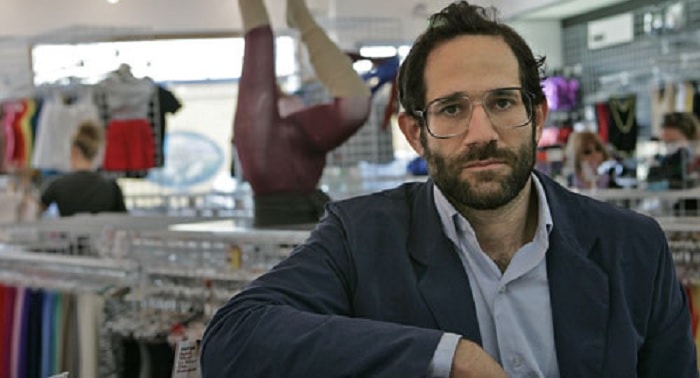
The last chapter of this tragedy might just have been drafted.
On the first Monday of October, with a crippling share price of just $0.11, America’s one-time retail heart-throb filed for Chapter 11 bankruptcy.
Slate magazine explains why this decision has been an excruciatingly long time coming:
“The once-trendy retail chain, has not turned a profit since 2009, is hemorrhaging sales, is facing worker allegations of intimidation, and, most importantly, is still struggling to keep its founder and jilted former CEO Dov Charney in check after firing him more than a year ago.”
Just google ‘the rise and fall of American Apparel’ and you’ll find the business media articles with an exact match title run well past page 1 and right back to The Guardian’s effort in 2010.
For half of the 2000’s, American Apparel was the innovative, disruptive hipster wunderbrand showing retail the way of the future. The company’s controversial Founder Dov Charney was a lovable eccentric. AA’s marketing was edgy and daring.
Fast forward to 2015 and the adjectives are all a little droopier.
American Apparel is more basket-case than basket-filler. There’s some sort of media-wide understanding to add the words “Notorious Creep And” in front of Dov Charney’s title of ‘Founder’. The only ‘s’ word not used to describe the brand’s marketing is successful. Sexist, sleazy, shocking and sickening are much more appropriate.
The company’s share price says more about the brand’s journey in one line than any journalist ever could:

From 2008 to *THUD* it’s been a grim state of affairs.
If you’re not familiar with the details of the fall of Dov Charney, here’s a one paragraph synopsis (a mere abstract of his rap sheet) from our read of the month to bring you up to speed:
“The former CEO masturbated in front of a Jane reporter, was the target of at least eight sexual-harassment lawsuits, and was sued by a former accountant who says he got fired for refusing to cook the books. Before Charney’s dismissal for alleged misuse of corporate funds and a series of sexual-harassment complaints (including allowing an employee to publish a blog with nude photos of another former colleague, otherwise known as revenge porn), his company had turned a quarterly profit only once in the previous five years, racking up losses totaling $300 million.”
For a more linear timeline of the rollercoaster that is America’s most colourful retailer, Los Angeles Racked has you covered.
The poster-brand of 10 years ago used to be cool. Suddenly we’ve grown up. The more-than-half-naked chick on the wall is now shameful and silly – a kind of embarrassing reminder that makes you mutter ‘what were we thinking?’
Our read of the month by author Alden Wicker tries to get to the heart of the question of the contradiction that is American Apparel.
How can one of America’s biggest retail fashion brands be so passionately worshipped and so hopelessly misguided, all at the same time?
The title of the article almost says it all:
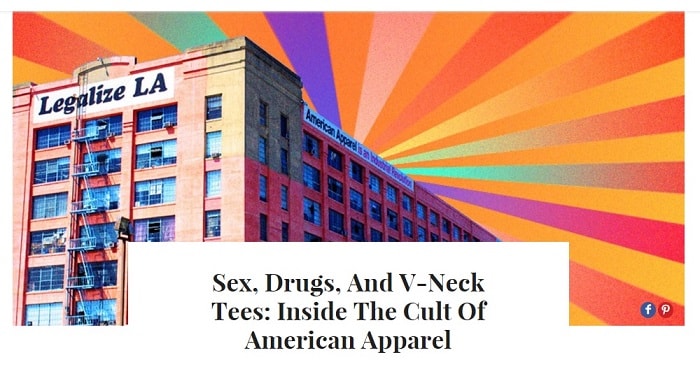
Last month, Brandchannel pinpointed the Dov Charney’s decision that led to American Apparel’s inevitable demise:
“Charney’s big mistake was not that he was too attached to the brand he built but that, in the end, he was not attached enough. (He) allowed AA to be acquired by investors that took the brand to Wall Street and sold it to shareholders.
American Apparel was no longer controlled by a single, albeit warped, visionary. It had thousands of little visionaries with nothing invested but money and a profit motive. Dov and American Apparel were doomed from the second he signed that deal.”
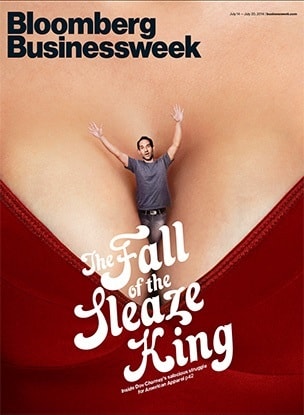 Bloomberg Business’s 2014 cover image paints a particularly entertaining portrait of the American Apparel retail soap opera that has descended into a modern day Shakesperean tragedy.
Bloomberg Business’s 2014 cover image paints a particularly entertaining portrait of the American Apparel retail soap opera that has descended into a modern day Shakesperean tragedy.
Our Read of the Month from Refinery 29 tells this confounding story.
Anyone with a passing interest in retail and branding will relish the paradox that is American Apparel.
If nothing else, taking a peek into the walking kaleidescope that is Dov Charney offers you a rollicking read in itself.
A little ecommerce Christmas Gift before you go
We know you’re busy preparing for the annual online shopping nightmare otherwise known as Christmas.
‘Tis the time of giving, and we gorillas are the sharing type, so we wanted to do something to help you through this anxiety-inducing time.
So we pulled together a whole stack of simple, practical Christmas marketing tips that you can implement right now, to help you make the most of the festive season stampede.
You should download and unwrap our Ecommerce Christmas Marketing Guide.
Read it, share it with your team, pick out a few ideas you think might help, and you’ll be able to meet, greet and keep more customers this Christmas.
Christmas is supposed to be about fun, laughter and happiness.
It’s the one time of the year when your online store gets the chance to impress a whole new bunch of potential lifetime customers. You should be excited!
You don’t need to be this guy for the whole of November-December.

Enjoy your early present from the Gorilla Santa. You’ll turn into this guy in no time.

All of the tribe are thinking of you this online shopping silly season.
We wish you a merry, stress-free and customer-friendly Christmas!
If you haven’t already, subscribe for next month’s ecommerce email helpfulness
One email, once a month, with free delivery straight to your inbox door.
We bring you up to speed with the most important issues in the online retail industry so you don’t feel like you’re missing out.
Or for those of you who missed out on September’s bundle of ecommerce learning, you can catch up on some big developments in the online versus offline debate, mobile commerce and retail innovation.
Until next month, our Christmas shopping best wishes are with you.
Gorilla out.
